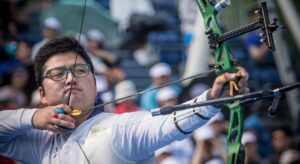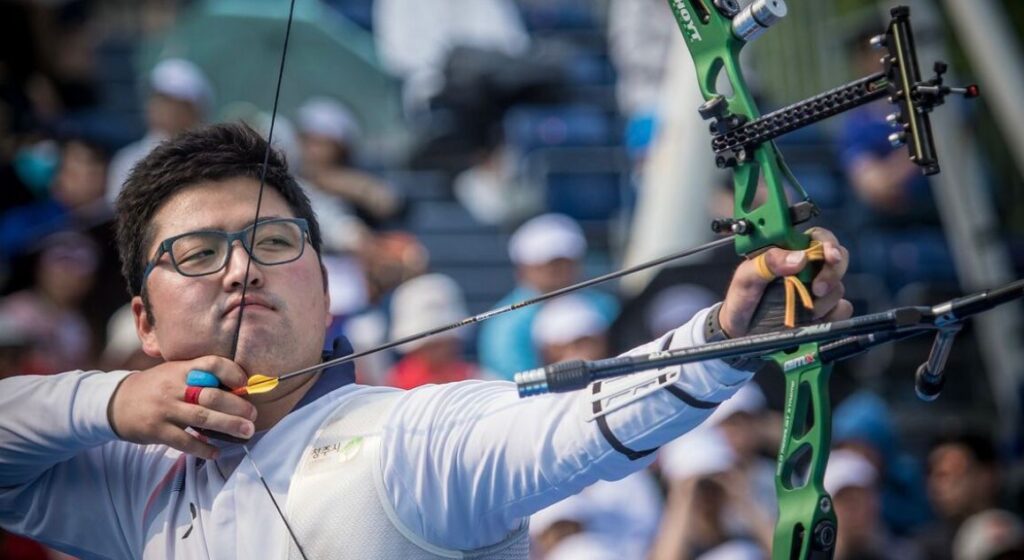
Kim Woo-jin is the world’s greatest men’s archer, and he has the medals to prove it. From Paris, he took home the individual, men’s team and mixed team gold medals. But that is merely one part of his story. Kim is now 32, an age when most archers start to fade. At his very peak, the Olympic gold proved elusive. That he came back to win it at the third time of asking speaks volumes of both his character and mental strength.
In Rio, eight years ago, Kim smashed the world record in qualification. He hit a scarcely believable 52 10s, including 26 inner rings. But in the men’s individual competition, he bombed out in the round of 32, after shooting 27, 24 and 27 in consecutive sets against Indonesia’s Riau Agata. In Tokyo five years later, he lost in the last eight to Chinese Taipei’s Tang Chih-chun, not managing more than 28 in any of the five sets.
So, when he was paired with Turkey’s Mete Gazoz, the defending Olympic champion, in quarterfinal, many did wonder if he could hold his nerve. Gazoz seldom produces gaudy numbers in qualifying but is a ‘clutch’ archer as he showed in Tokyo. And with Kim shooting a 7 in the opening set and an 8 in the fourth, Gazoz took the match to the wire. Only, this time, Kim summoned up two straight 10s to take it.
The semi-final against Lee Woo-seok saw archery of the highest quality, with the two trading 10s. Kim hit ten of them in his 15 arrows, but still needed a shoot-off – where he struck another 10 – to prevail. The final was no different, with the USA’s Brady Ellison leading 4-2. This time, Kim reeled off five straight 10s to take it to a shoot-off, where he hit the inner ring. Poor Ellison had 10s in each of his last five arrows, but still lost.
This is what Dhiraj Bommadevara needs to learn from. There is little doubt that Dhiraj was unlucky. First, with the draw. Eric Peters, his round-of-32 opponent, is a top archer but qualified poorly, meaning he ran into Dhiraj early on. But Peters finished that match with seven straight 10s, including one in the shoot-off. The chances of that happening are statistically tiny.
Dhiraj himself had six 10s in his last seven arrows, but when he needed the 10 that would have sealed the match, he couldn’t find it. You can either put it down to wretched luck, or accept that the highest echelon of archery, or any other sport, requires ruthlessness.
It was no different in the women’s section, where Lim Si-hyeon, just 21, came from 2-4 down in both her quarterfinal and semi. On both occasions, she shot four 10s in her last six arrows. In the final against Nam Su-hyeon, she left nothing to chance, finding the 10s an astonishing 11 times in 15 arrows.
Nam had beaten India’s Deepika Kumari in the last eight. Deepika led 2-0 and 4-2, and each time, she shot the most wretched arrows to relinquish the lead. If it was a 6 in the second set, it was 7 in the fourth. And in the decisive fifth set, Nam produced two 10s and a 9, while Deepika couldn’t find a single maximum.
In other Olympic news:
Paris Olympics 2024: Will Lakshya Sen bring home a medal? Avinash Sable in action & more https://t.co/hm6QaJFQGQ
— RevSportz Global (@RevSportzGlobal) August 5, 2024
Bhajan Kaur had a similar experience. In a match where both archers were extremely erratic, she had taken Indonesia’s Diananda Choirunisa to a shoot-off with a final shot of 10. In sudden death, Choirunisa’s arrow was a 9. But with a place in the quarterfinals there for the taking, Bhajan shot an 8.
She only turns 19 later this month and should be in her prime come the Los Angeles Olympics in 2028. But if Indian archery’s cycle of chronic underachievement is to be broken, at least one individual needs to come up with a clutch performance and smash through the glass ceiling.
It’s not as though Kim and Lim were born Zen masters. But the way they mastered difficult situations was incredible to behold, especially Lim in her first Olympics. If there’s some secret sauce or meditation technique involve, the Indians need to learn it. Otherwise, there will only be more hard-luck stories, and no medals.
For more sports content: https://revsportz.in/




